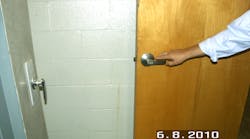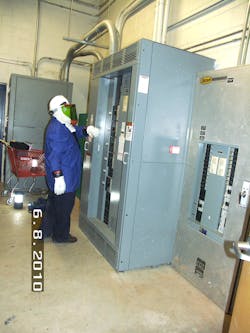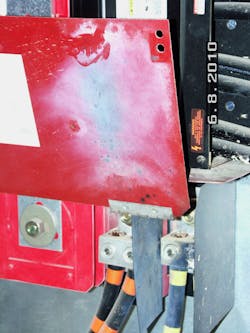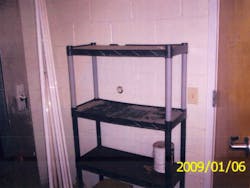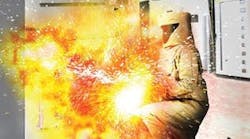Thou shall not use an electrical room for storage!” We all know this rule as one of the electrical commandments, right? At least that’s what I thought. However, when I looked in the NEC, I couldn’t find it anywhere. Upon further investigation, I realized it is actually not a Code requirement, but rather a good practice, as is noted in 110.26(B) and evidenced by the lesson in this forensic case study. It all started when an experienced electrician was dispatched to a big box store for what he thought was a typical service call. This was not his first visit to the store’s equipment room. On previous occasions, he’d operated circuit breakers at the facility but never removed any panel covers. This time was different.
Setting the Stage
The store manager was not happy because the ballasts in the fluorescent luminaires over the sales area were failing frequently. Because the main electrical room, which had two entrances, was locked, the manager had to unlock one of the doors for the electrician. The manager unlocked the interior door in the general back office area. The other door, which was equipped with an emergency push bar and opened to the outdoors, was located at the opposite end of the room. Although there was no sign posted on the door identifying it as an electrical equipment room, it was locked to prevent unauthorized entry.
The Accident
The electrician arrived on-site with his tool belt, hand tools, and gloves but no personal protective equipment (PPE). The company he worked for — a large regional electrical contractor — just so happened to be in the process of issuing PPE to all of its workers. Previously, PPE was available for a minority of employees, generally provided on an “as-needed” basis if the worker reserved it ahead of time. Because this was a simple service call, the electrician hadn’t made arrangements to check out PPE. Although the electrician was trained to use the gear, he had never actually used it in the field — he’d only watched a video on proper usage.
The electrician proceeded to change out the ballasts. He did not switch the circuit breaker off prior to doing so because these units had plug-type disconnects that allow you to swap them out “hot.” After changing out the first ballast, the electrician checked the connection and voltage level at the 20A circuit breaker in the 277/480VAC lighting panel. He removed his tool belt and the panel cover, placing his clamp-on meter on the panel enclosure, which was located about 10 ft from the front door. He bent down in front of the panel, preparing to perform a visual examination when he heard the door open. The next thing he knew something was falling toward him.
Although he hadn’t noticed it upon entering the room initially, there was a shelving unit situated behind the door that held many storage items — one of which was a chain saw resting on the top shelf. As shown in Photo 1, notice how the door swings inward. Due to the substantial weight of the chain saw, the structure’s center of gravity produced a downward tipping force when it was hit by the opening door.
Reflexively, the electrician raised his right arm to protect his head when he saw the falling objects. The next thing he remembered he was sitting up against the panel cover, which was propped up by the main distribution cabinet (Photo 2). As shown in Photo 3, the chain saw struck the right bottom phase lug, resulting in arc flash damage to the red shield. The arc blast was heard in all offices.
The Aftermath
The electrician’s resulting injuries were more a result of the blast shock wave than burns. There was no evidence of classic electrical entry and exit wounds. EMS was called immediately, and the victim was transported to a specialty burn unit. Burns to the top of his head indicated that he was fortunately oriented face down at the time of the accident. Symptoms of blast-related traumatic brain injury (TBI) seemed to be the best fit for the electrician’s permanent impairment condition.
When I met the victim two years after the accident, he was still unable to walk without a brace, had no short-term memory, and was in rehab for stroke symptoms on his left side. His marriage had ended, and his future indicated lifetime support needs. Because the workman’s comp claim was insufficient to cover the victim’s extensive rehabilitation costs and loss of income, the electrician filed suit against the big box retailer. I was hired by the victim’s attorney to analyze the electrical forensic evidence in the case and determine the cause of the accident as well as liability.
The Investigation
At my initial site visit, I was accompanied by the electrician, his attorney, the defense attorney, employees of the electrician’s previous employer, and the store manager. The electrician’s former employer had an electrician with him who wore full PPE when removing the lighting panel cover and dead front, which covers exposed wiring to the breakers. After he finished removing the covers, the 200A circuit breaker feeding the lighting panel was turned off. We were told we were not allowed to approach within 5 ft of the panel while it was energized.
Now that the panel was de-energized, we asked the other parties to leave the room. This left me, the electrician, and the lawyer. Once the other parties had vacated, I asked the electrician to place his clamp-on meter where it was at the time of the accident and show me where and how he was positioned. Working with this information, I could establish a theory of how the chain saw fell and was ultimately deflected by his right arm into the panel. This would have put the impact point area at the bottom of the panel, which was the feeder location.
After lifting the arc shield, I could see the orientation of cables at the bottom of the panel. I was also able to match up the damage to the chain saw to the panel. Given the amount of smoke char to the back of the shield, I concluded the chain saw fault was between the line and ground. This placed the electrician about 2 ft to 3 ft in front of the arc flash location.
Independent and store incident investigations confirmed that at the time of the accident there was an electric chain saw resting on the top shelf of the 5-ft plastic sectional shelving unit adjacent to the interior door. Paint cans were also stored on lower shelves, as shown in Photo 4. The damage I observed to the chain saw obviously had to come from contact with an energized source, as shown in Photo 5. Unfortunately, the chain saw had been lost and never located, although it was being held as evidence (according to the store manager).
My examination of damage to the chain saw bar based on a single image from the scene indicated arc damage at two points consistent with contact with the lug and grounded cabinet. I marveled at the small probability of how the original and deflected fall trajectory resulted in coincidental alignment with the shield edge.
Who Done It?
Despite these conclusions, one question remained: Who opened the door? The electrician was able to recall a familiar-looking woman opening the door prior to the impact; however, deposition testimony did not reveal the responsible party. There were several women working in adjacent offices who were aware someone was working in the electrical room. My working theory was that one of these women opened the door to check on the electrician or see what was going on. In the process of doing so, the door struck the shelf, causing the unit to tip over and launching the chain saw toward the victim.
Forensic Analysis
Clearly, the store had violated a number of its own policies that expressly prohibited using an electrical room for storage. Store policy also required shelves loaded with the heaviest objects at the bottom, which effectively lowers the center of gravity. Had the chain saw been located on the bottom shelf per store requirements, this accident would not have occurred.
It was discovered during deposition testimony that the chain saw was used to trim Christmas trees — and had been stored in the electrical room for quite some time. There was no question that the chain saw was stored in violation of store policy with respect to its presence and location. The fact that the chain saw disappeared post accident did not help the defendant’s case either.
Legal Arguments
The store’s litigation team argued that if the electrician had been using appropriate PPE he would not have been injured. Although I agreed that PPE would have protected him from burns, I argued it would not have prevented the shock wave injuries and resulting TBI. In the end, the case settled out of court in favor of the victim for an undisclosed amount prior to trial.
Lessons Learned
The moral of this story is that even innocuous storage in an electrical room should not be allowed and always reported to management. Of course, we know this happens all too frequently. After seeing the results of this improbable accident, I know I will always admonish responsible parties to remove any and all stored items from electrical rooms. In the end, your willingness to follow this unwritten electrical commandment may save your life and the lives of others.
Greene is a licensed mechanical/electrical engineer for Orbital Engineering and Consulting in Charleston, S.C. He can be reached at [email protected].
